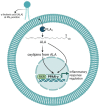The Role of α-Linolenic Acid and Its Oxylipins in Human Cardiovascular Diseases
- PMID: 37047085
- PMCID: PMC10093787
- DOI: 10.3390/ijms24076110
The Role of α-Linolenic Acid and Its Oxylipins in Human Cardiovascular Diseases
Abstract
α-linolenic acid (ALA) is an essential C-18 n-3 polyunsaturated fatty acid (PUFA), which can be elongated to longer n-3 PUFAs, such as eicosapentaenoic acid (EPA). These long-chain n-3 PUFAs have anti-inflammatory and pro-resolution effects either directly or through their oxylipin metabolites. However, there is evidence that the conversion of ALA to the long-chain PUFAs is limited. On the other hand, there is evidence in humans that supplementation of ALA in the diet is associated with an improved lipid profile, a reduction in the inflammatory biomarker C-reactive protein (CRP) and a reduction in cardiovascular diseases (CVDs) and all-cause mortality. Studies investigating the cellular mechanism for these beneficial effects showed that ALA is metabolized to oxylipins through the Lipoxygenase (LOX), the Cyclooxygenase (COX) and the Cytochrome P450 (CYP450) pathways, leading to hydroperoxy-, epoxy-, mono- and dihydroxylated oxylipins. In several mouse and cell models, it has been shown that ALA and some of its oxylipins, including 9- and 13-hydroxy-octadecatrienoic acids (9-HOTrE and 13-HOTrE), have immunomodulating effects. Taken together, the current literature suggests a beneficial role for diets rich in ALA in human CVDs, however, it is not always clear whether the described effects are attributable to ALA, its oxylipins or other substances present in the supplemented diets.
Keywords: DiHOTrE; EpODE; HOTrE; cardiovascular disease; inflammation; lipid mediators; mortality; oxo-OTrE; oxylipins; α-linolenic acid.
Conflict of interest statement
The authors declare no conflict of interest.
Figures


Similar articles
-
Anti-inflammatory effects of α-linolenic acid in M1-like macrophages are associated with enhanced production of oxylipins from α-linolenic and linoleic acid.J Nutr Biochem. 2018 Jul;57:121-129. doi: 10.1016/j.jnutbio.2018.03.020. Epub 2018 Apr 3. J Nutr Biochem. 2018. PMID: 29698923
-
Dietary n-6 and n-3 PUFA alter the free oxylipin profile differently in male and female rat hearts.Br J Nutr. 2019 Aug 14;122(3):252-261. doi: 10.1017/S0007114519001211. Br J Nutr. 2019. PMID: 31405389
-
Cardiac oxylipin perturbances in response to 2-monochloropropane-1,3-diol exposure are ameliorated by dietary adequacy of the essential n-3 fatty acid, α-linolenic acid.Food Chem Toxicol. 2024 Dec;194:115080. doi: 10.1016/j.fct.2024.115080. Epub 2024 Nov 2. Food Chem Toxicol. 2024. PMID: 39491768
-
Crosstalk between adenosine receptors and CYP450-derived oxylipins in the modulation of cardiovascular, including coronary reactive hyperemic response.Pharmacol Ther. 2022 Dec;240:108213. doi: 10.1016/j.pharmthera.2022.108213. Epub 2022 May 18. Pharmacol Ther. 2022. PMID: 35597366 Review.
-
Advances in Our Understanding of Oxylipins Derived from Dietary PUFAs.Adv Nutr. 2015 Sep 15;6(5):513-40. doi: 10.3945/an.114.007732. Print 2015 Sep. Adv Nutr. 2015. PMID: 26374175 Free PMC article. Review.
Cited by
-
Chemical Profiling of Polar Lipids and the Polyphenolic Fraction of Commercial Italian Phaseolus Seeds by UHPLC-HRMS and Biological Evaluation.Biomolecules. 2024 Oct 20;14(10):1336. doi: 10.3390/biom14101336. Biomolecules. 2024. PMID: 39456269 Free PMC article.
-
Evaluation of Influencing Factors on Metabolism of Land-Based n-3 Poly Unsaturated Fatty Acids-The KoALA Study.Nutrients. 2023 Oct 20;15(20):4461. doi: 10.3390/nu15204461. Nutrients. 2023. PMID: 37892536 Free PMC article. Clinical Trial.
-
Multi-omic signatures of host response associated with presence, type, and outcome of enterococcal bacteremia.mSystems. 2025 Feb 18;10(2):e0147124. doi: 10.1128/msystems.01471-24. Epub 2025 Jan 21. mSystems. 2025. PMID: 39835799 Free PMC article.
-
The Octadecanoids: Synthesis and Bioactivity of 18-Carbon Oxygenated Fatty Acids in Mammals, Bacteria, and Fungi.Chem Rev. 2025 Jan 8;125(1):1-90. doi: 10.1021/acs.chemrev.3c00520. Epub 2024 Dec 16. Chem Rev. 2025. PMID: 39680864 Free PMC article. Review.
-
Ferroptosis and protein translation: emerging perspectives in the research of myocardial infraction.Front Cardiovasc Med. 2025 May 2;12:1592333. doi: 10.3389/fcvm.2025.1592333. eCollection 2025. Front Cardiovasc Med. 2025. PMID: 40384965 Free PMC article. Review.
References
-
- Burr G.O., Burr M.M. On the nature and rôle of the fatty acids essential in nutrition. J. Biol. Chem. 1930;86:587–621. doi: 10.1016/S0021-9258(20)78929-5. - DOI
Publication types
MeSH terms
Substances
Grants and funding
LinkOut - more resources
Full Text Sources
Research Materials
Miscellaneous

